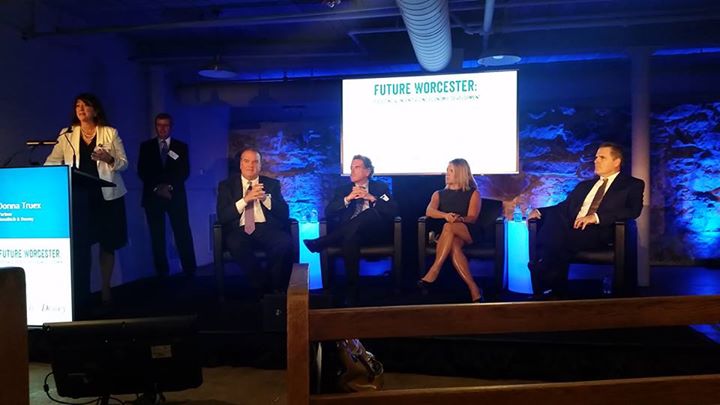Economic Development Successes, Challenges and Opportunities Examined at “Future Worcester” Event

See more photos from the Future Worcester event on the Bowditch & Dewey Facebook page HERE.
Bowditch & Dewey recently hosted “Future Worcester: Focusing & Incentivizing Economic Development” at the historic Crompton Collective in Worcester. The event featured a candid, pragmatic discussion on the state of Worcester’s real estate development market and ways in which the city can spur and incentivize growth.
The keynote speaker was Colin Kane, a founding partner of Peregrine Group LLC and Peregrine Property Management LLC, which are real estate development, property management and advisory firms with offices in Rhode Island and Boston. Bob Longden, a Partner with Bowditch & Dewey, moderated a discussion among four prominent panelists, Craig L. Blais, President and CEO of Worcester Business Development Corp., Michael V. O’Brien, Executive Vice President of Wynn Development and former Worcester City Manager, Sherri Pitcher, Director of Business Recruitment of Worcester Regional Chamber of Commerce, and Michael E. Traynor, Chief Development Officer of the City of Worcester.
The room was bustling with people and ideas. Attendees included an eclectic mix of city stakeholders, including developers, business and political leaders, city officials, educators, public utility representatives, engineers, architects, accountants and lawyers. It was particularly impressive to see a significant number of young professionals in attendance who were fully-engaged with Colin Kane and the panelists both during the formal discussion and the networking and cocktail hours.
I kicked off the discussion with opening remarks and Colin Kane explained some of the return on investment realities of the Worcester development market. One key challenge developers face is that construction costs in Worcester are generally the same as compared to other parts of Massachusetts, including Boston, yet Worcester rental rates and resale values are low.
Like many cities, Worcester faces its fair share of challenges with respect to the utilization of union versus non-union labor, which also contribute to construction cost and management issues. Despite relatively low taxes, operating expenses, property management fees and other carrying costs, Colin Kane succinctly laid out the typical project proforma challenges that many developers struggle with when looking to invest in Worcester.
The panelists agreed that undesirable projected financial returns and market capitalization rates for projects in Worcester have kept many wary investors on the sidelines. However, through collaboration among developers, Federal, State and city officials and staff, political leaders, permitting boards, lenders and others, a substantial number of major development projects have managed to be successfully completed in Worcester in just the last decade. Craig Blais called out just a few of these projects by name, including City Square, the new regional transit hub adjacent to historic Union Station, the convention center expansion at the DCU Center, Gateway Park at WPI, redevelopment of the former Telegram and Gazette Building, the new Unum building, the CSX intermodal terminal expansion and a number of development projects by the city’s colleges and universities and secondary schools. He noted that 20 years ago very few people thought such developments were possible.
More recently, market rate multi-family residential projects are being developed in once-blighted parts of the city where people have not resided in decades. A new full-service luxury hotel has broken ground. Single family residential subdivisions are being created. The panelists agreed that these types of developments are game changers, and are an indicator that development in the city may be on the rise.
In order to make the numbers work, major projects require some combination of Federal, State and local grants, tax credits (e.g., new markets, historic and brownfields), tax increment financing, district improvement financing and other government subsidies. However, the panelists indicated that the availability and administration of such monies, especially from the State, need to be made more predictable for, and accessible to, Worcester projects. Lenders, particularly community banks with local interests, should continue to collaborate on projects by pooling funds to spur project growth and spread liability and the risk of default.
The collaborative, hands-on approach to development and permitting by the city’s officials, staff, boards and the Worcester Redevelopment Authority have played a vital role in bringing about major improvements to the city’s urban landscape over the last decade. The panelists said that the city’s most neglected properties can depress property values within an entire neighborhood for years, and measured but aggressive use of eminent domain power must be employed in order to kick-start and/or support development efforts. The panelists noted that the city’s Master Plan and zoning need to be updated in a way that provides a more clear vision for development growth. The city’s inventory of distressed, abandoned and brownfields properties need to be better marketed to investors both locally and nationally.
The panelists pointed out that there are over 36,000 students attending the city’s 11 colleges and universities, and like many college-cities, Worcester faces its own so-called town and gown challenges. However, one of the biggest issues Worcester faces is what happens to these highly educated students upon graduation. Recruiting, retaining and incubating graduates is a challenge for Worcester as many opt to move to places like Boston, New York and Austin upon graduating.
The city and organizations like Worcester Regional Chamber of Commerce are working with schools and employers to inform people about, and promote, the city’s great restaurants, performing arts, museums, recreational facilities, reasonably-priced housing options, world-class hospitals, senior living facilities, commuter rail service and other amenities and benefits to encourage students and young professionals to live, work, play and/or retire in Worcester. The nonstop train into Boston will hopefully serve to incentivize people to actually reside in the growing market-rate housing developments that are now being built. Although public schools and safety must be improved in order to truly drive families to live in Worcester.
Colin Kane correctly observed that Google may never open an office in Worcester; however, other discussion during the event centered around how the city can compete with the high tech meccas of the Commonwealth such as Waltham, Burlington, Cambridge, I-95 and I-495. Thousands of programmers, software and hardware engineers and information technology professionals have graduated from Worcester schools, or if not alums of such schools, are otherwise currently residing in towns such as Shrewsbury, Westborough and Southborough, and could easily work in Worcester if the city could attract high tech companies. Although not a high tech company per se, UMass Memorial Health Care recently announced that it will be bringing 500 information technology jobs to downtown starting by the end of this year.
The day before this event was held was “Back to the Future Day”, marking the 30th anniversary of the famous time-traveling movie starring Michael J. Fox. For those familiar with the movie, time does “fly”, and the movie itself forces us to think about the dramatic change that can happen over time to people, places and cultures. Bowditch & Dewey just celebrated its 100th year anniversary. The city and its people, industry and institutions have certainly changed over those 100 years, and many might argue that the city’s best days are behind it.
But people who have lived and/or worked in the city over the past 10 years and have witnessed the dramatic developments that have occurred despite problematic proformas, would beg to differ. There’s excitement in the air because there are cranes in the air. This great gateway city is in midst of a renaissance. Let’s continue to build upon the city’s already strong foundations (pun intended), and keep the dialogue going on how we can bring our shining city on a hill to new heights.
Categorized: Uncategorized



